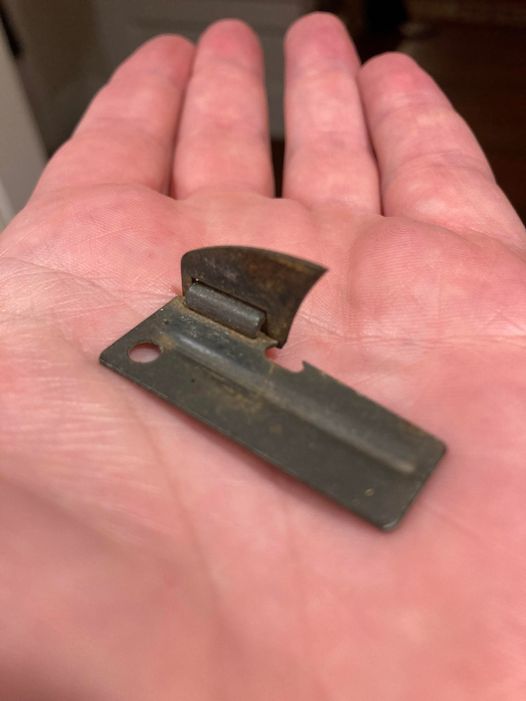In the palm of your hand, this small, unassuming metal tool might not immediately reveal its rich history. This is the P-38 can opener, a tiny yet ingenious device issued to military personnel beginning in World War II. Though it looks simple, this little tool is a symbol of practicality and ingenuity from a time when design needed to be efficient, compact, and effective—especially in the battlefield. The P-38 is more than just a can opener; it’s a piece of history that has proven its worth, generation after generation.

A Hidden Treasure in Your Kitchen Drawer
In today’s world, where every kitchen seems filled with high-tech gadgets and electric appliances, finding a P-38 can opener at the back of a drawer feels like discovering a long-lost relic. Unlike today’s tools that need charging, updating, or replacing every few years, the P-38 comes from an era when things were built to last. It’s a reminder of a time when resourcefulness and simplicity were valued. The P-38 may be small, but it’s a testament to the ingenuity of earlier generations. Its presence in a modern kitchen feels like a bridge to the past, a nod to the days when tools didn’t just solve problems—they were made to endure.
The P-38: A Soldier’s Trusty Companion
Imagine a soldier far from home, relying on field rations for sustenance. In his pocket, he carried the P-38 can opener, a simple piece of folded metal that made opening those cans of food possible. This tool wasn’t just about function—it was a lifeline. Soldiers needed something that wouldn’t take up much space or weigh them down, but would always be reliable. The P-38 fit the bill perfectly. It wasn’t bulky or complicated, just a handy companion that performed a vital task.
For soldiers, the P-38 did more than open cans. It opened moments of camaraderie. As they sat together to share meals in harsh conditions, this tiny tool allowed them to pause, connect, and create small moments of normalcy amid the chaos of war. In this way, the P-38 became more than just a tool—it became part of the soldier’s daily life, a quiet yet reliable presence during times of uncertainty.
Survival and Simplicity
The efficiency of the P-38 has ensured its continued use, even today. Outdoor enthusiasts, survivalists, and collectors still appreciate this small but mighty tool. It doesn’t require electricity or batteries. There’s no instruction manual, no moving parts that need maintenance. It’s just a simple piece of metal that does exactly what it was designed to do—open cans. Its simplicity is its genius. It’s a marvel of minimalism and serves as a reminder that sometimes, the most effective tools are the least complicated.
Minimalism in the Modern World
Modern can openers may boast all sorts of features—ergonomic handles, electric motors, even automatic functions—but they often lack the charm and practicality of the P-38. There’s something incredibly satisfying about using such a basic, no-frills tool. When you hold a P-38 in your hand and use it, you’re engaging with history in a tangible way. It connects you to a time when people valued durability and function over convenience. This little gadget is a piece of the past that has managed to survive in a world that often values convenience over craftsmanship.
Timeless Design
Rediscovering the P-38 can opener invites us to pause and appreciate the brilliance behind its design. The people who created it didn’t just solve a problem—they crafted a tool that has stood the test of time. The P-38 was never flashy or overdesigned. It was made for a specific purpose and it fulfilled that purpose with simplicity and elegance. And that’s why it still resonates today.
In a world where innovation is often defined by what’s new and cutting-edge, the P-38 reminds us that some designs are truly timeless. It serves a purpose, endures the years, and continues to tell a story long after its initial creation. The P-38 can opener, with its straightforward yet effective design, remains a quiet icon of ingenuity, reminding us that sometimes the best innovations aren’t those that rely on the latest technology, but those that are crafted with intention, simplicity, and longevity in mind.





